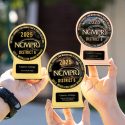First Drone Journalism Class Takes Off
Fullerton College has launched its first Drone Journalism class, the first of a full drone-based program slated to open in the fall.
The first drone class, which started this spring semester, goes over how to pilot and use a drone, laws pertaining to drone use and, of course, how to use drones for journalism, said Professor Jay Seidel, Media Studies Department Coordinator and head of the new drone program.
Plans are in the works to offer a number of additional drone classes in fall, such as a 2-unit Drone Piloting course, a 1-unit drone pilot license test-prep course and a more robust Applied Drone Piloting course, which will include unofficial focuses, such as surveying, search and rescue, film making and infrastructure inspection. Also, a counter-drone technology course catering to law enforcement, emergency workers and security professionals is in the early planning phases.
The Technology and Engineering Division also plans to incorporate drones into its Engineering Department with a class called Applied Drone Lab, which will allow students to build their own drone: either aerial, terrestrial or submersible.
The inspiration for the program came from a trip Seidel took to University of Oregon for a three-day drone training seminar. There, he saw drone photographer Johnny Miller’s work “Unequal Scenes,” which illustrates economic disparity through aerial photography of wealthy neighborhoods abutting low-income areas. Seidel then realized drones had enormous potential for journalism.
“(The economic disparity) was so visible, but from the ground, you can’t see it. It gives you scope and context like you wouldn’t believe,” Seidel said. “I said, ‘I’m in.’ We’re flying drones and it’s awesome!”
When Seidel brought up the idea with Ken Starkman, dean of the Technology and Engineering Division, he saw how drones could be useful for a number of different fields and suggested expanding it into an independent program.
“Drone technology is a game changer, and our classes are a critical part of this new revolution,” Starkman said. “The drone program is another example of how Fullerton College is on the technological forefront by quickly putting new courses in place that give the high-tech advantage to our students.”
Strong Workforce, a statewide program that expands community college offerings that teach in-demand technical skills, is funding drone class development. A regional Strong Workforce group, comprised of community colleges in the greater Los Angeles and Orange County area, is working to assess the future employment potential of drone pilots.
At the moment, many industries that could use drone technology are not because too few people in the workforce know how to use them, Seidel said.
“Before, Uber was just taxis, and it was small. Then, they let lay people start driving, and the demand exploded,” Seidel said. “I think the demand is going to increase exponentially when more people with this skill set enter the workforce.”
One obstacle preventing organizations from exploiting drone’s full potential is existing laws. For example, rail company BNSF could use drones to fly the length of its rails to survey their condition, but current laws require a drone to stay in the pilot’s line of sight.
The drone program brought new high-tech gear to the campus, including numerous drones and a Chevy Tahoe equipped with monitors and tracking equipment that communicates with as many as four drones simultaneously and transmits a visual feed to the campus.
Students during the first week of class said they were excited to get some hands-on experience.
“Drones are something that’s going to be big in the future, and I want to be part of it,” said Bryan Cisneros, 19, of Anaheim. “I feel like I’m part of history!” He aspires to be a filmmaker and hopes drones will let him get shots that would otherwise be too expensive.
Emily Viveros, 26, of Fullerton, signed up for the class because she works for an agricultural business that recently bought drones equipped with thermal cameras. Her boss wants to survey the company’s orchards to find temperature irregularities, but nobody knows how to use the technology.
So Viveros volunteered to learn. “This technology is super new and that’s why I’m so excited,” she said.






